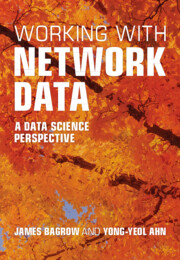Book contents
- Frontmatter
- Contents
- Preface
- Part I Background
- Part II Applications, tools, and tasks
- Chapter 5 The life cycle of a network study
- Chapter 6 Gathering data
- Chapter 7 Extracting networks from data — the “upstream task”
- Chapter 8 Implementation: storing and manipulating network data
- Chapter 9 Incorporating node and edge attributes
- Chapter 10 Awful errors and how to amend them
- Chapter 11 Explore and explain: statistics for network data
- Chapter 12 Understanding network structure and organization
- Chapter 13 Visualizing networks
- Chapter 14 Summarizing and comparing networks
- Chapter 15 Dynamics and dynamic networks
- Chapter 16 Machine learning
- Interlude — Good practices for scientific computing
- Part III Fundamentals
- Conclusion
- Bibliography
- Index
Chapter 10 - Awful errors and how to amend them
from Part II - Applications, tools, and tasks
Published online by Cambridge University Press: 06 June 2024
- Frontmatter
- Contents
- Preface
- Part I Background
- Part II Applications, tools, and tasks
- Chapter 5 The life cycle of a network study
- Chapter 6 Gathering data
- Chapter 7 Extracting networks from data — the “upstream task”
- Chapter 8 Implementation: storing and manipulating network data
- Chapter 9 Incorporating node and edge attributes
- Chapter 10 Awful errors and how to amend them
- Chapter 11 Explore and explain: statistics for network data
- Chapter 12 Understanding network structure and organization
- Chapter 13 Visualizing networks
- Chapter 14 Summarizing and comparing networks
- Chapter 15 Dynamics and dynamic networks
- Chapter 16 Machine learning
- Interlude — Good practices for scientific computing
- Part III Fundamentals
- Conclusion
- Bibliography
- Index
Summary
Network data, like all data, are imperfect measures of objects of study. There may be missing information or false information. For networks, these measurement errors can lead to missing nodes or links (network elements that exist in reality but are absent from the network data) or spurious nodes or links (nodes or links present in the data but absent in reality). More troubling is that these conditions exist in a continuum, and there is a spectrum of scenarios where nodes or links may exist but not be meaningful in some way. In this chapter, we describe how such errors can appear and affect network data and introduce some ways to handle such errors in the data processing steps. Fixes for errors can lead to different networks, before and after processing, for example, and we must be careful and circumspect in identifying and planning for such errors.
Keywords
- Type
- Chapter
- Information
- Working with Network DataA Data Science Perspective, pp. 117 - 136Publisher: Cambridge University PressPrint publication year: 2024

